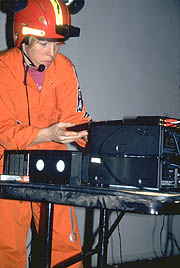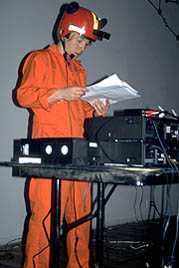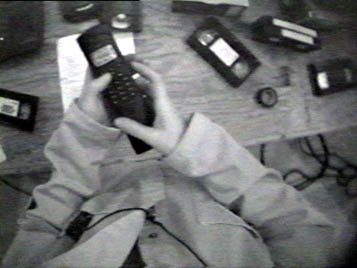


PERFORMANCES
A Common Object has Special Powers..., 1997/98, Live Mix and Spoken Word Performance, roughly 20min
This live mix and spoken word performance is messy and noisy, melodic and poetic - the blacksheep relative to a seemless corporate presentation. The performance showcases Lucas as a multi-task performer. Like a computer she is a 'behind-the-scene' producer, and at the same time technical support and performer. The performance has been disrupted by events such as pizza delivery, missing cables, and mispatches. It ranges from 8-30 min in length.
The performance is both structured and improvised. Technical problems with the equipment are partners to the script, some of which are picked up by a small surveillance video camera (mounted ontop of a helmet) and projected wall-size behind the artist. Other configurations included a helmet fitted with speakers resembling Mickey Mouse ears, a helmet mounted video projector, and a gutted video mixer retrofitted onto a children's toy guitar. The audio and video samples derive from old and new video games (including a computer game version of DDR), footage collected from dumpster diving (Epcot Center promos, Hey Koolaid commercial, kid aerobics, Japanese soaps, and bad sci-fi).
Production assistance for the audio portion of A common object has special powers... was provided by Harvestworks through the 1997 New Works Residency. Production assistance for the video portion of this performance was provided by the Experimental Television Center which is supported in part by the New York State Council on the Arts and the National Endowment for the Arts and by private contributions.
Drag and Drop, 1999, Interactive Video Performance, 20-40min
"The conditions surrounding a performance are never easy to control. One deals with the acoustics of the space, the energy of the audience, the day of the week,... athletes face similar challenges ranging from sun in the eyes to home court advantage. Performers expect to have good moments and not-so-good moments, this comes with the territory. I allow this all to come to the surface in Drag and Drop. Tennis seemed like an appropriate metaphor through which to work out my performance anxiety."
"The court is been modified. It's not regulation in size. Half of it will be laid out on the floor and the other half projected onto the wall in front of me. The audience has the choice of watching me play the set from chairs around the court or from the monitors at the bar."
"The competitors exist in various forms. I am competing against the performance space for one. Then I am competing against my fool idea for a performance. There is my endurance, and of course my pride which can be read from the expression on my face. I will have live cameras in the space to pick up reactions from my audience as well as my moves as I run across the court. These images will be linked to monitors at the bar and a large video projection which makes up the other half of the court."
"I don't really think of Drag and Drop as a solo performance. The audience is also participating and they're probably more skilled anyway, then there is the ball boy. Benefits? I get to set the pace. An endless number of time outs and water breaks."
"The title of this performance has a reference to hand and eye coordination. Drag and Drop on a computer is about being efficient while in the physical world it seems like a last resort, task completion versus abandonment."
Quotes taken from an interview with Kristin Lucas by Samantha Berman.